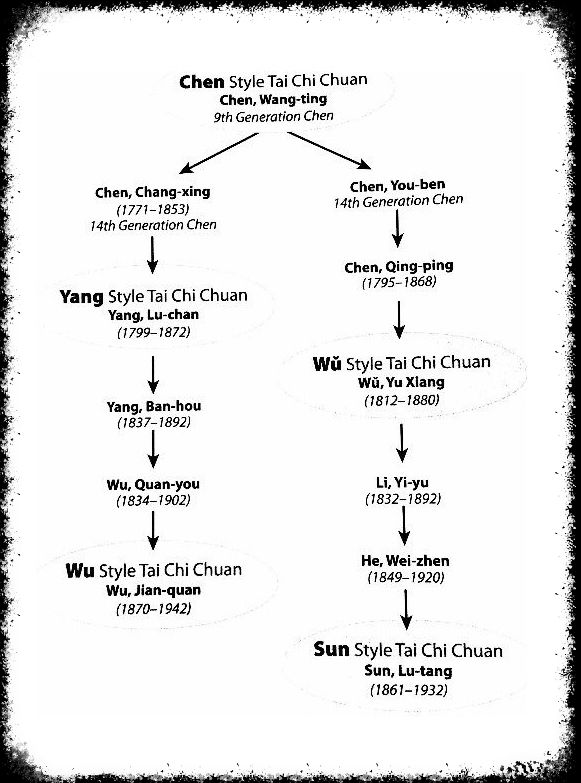
Timeline of the common styles
Chen Style
Chen Style is the oldest Tai Chi style basically the grandfather of all today's Tai Chi styles, which is characterized by silk reeling, alternating fast and slow motions, and bursts of power.
Chen Wangtin initially developed a set of boxing routines influenced by his military knowledge. This set was passed on the Chen Changxing (1771-1853), which was improved and standarized into two routines. At the same time Chen You-ben created another routine based on the original set of boxing routines. This created two branches in the Chen Style which from then onwards became independent over the next hundreds of years.
Each branch developed other Tai Chi style that emphasizes different aspects of the oldest internal martial art Tai Chi.
Yang Style
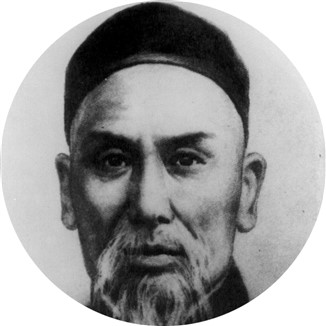
Master Yang Luchan
The art of Tai Chi was only passed on from master to a few selected students. Hence the knowledge of the Chen style was kept within the family for almost 300 years. Around the 14th generation Chen Chanxing taught the art of the Chen style to Yang Luchan which became the founder of the yang style Tai Chi. This was the first Tai Chi style taught outside the Chen family which became very popular in China and even today it is the most practiced one.
The Yang style is a very beautiful style with the movements being large, circular and very graceful. There is also a balance in the way how Yang style included movements going in both directions and some postures are done equally to the right and to the left.
Yang style simplified the overall forms by removing the physically difficult ones such as jumps, spins and strike. Also force has been minimized which makes even more a softer style. The Yang style forms emphasizes more on the health aspect of the practitioner which leads to better flexibility and wellness.
The Yang family-style Tai Chi in its many variations is the most popular and widely practiced style in the world today and the second in terms of seniority among the primary five family styles of Tai Chi. This style is suitable for young and old and can be practice even with health difficulties.
Wu Style
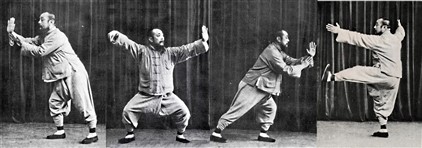
Master Wu Quanyou
Wu style was founded by Wu Quanyou, a disciple of Yang Luchan, which was later popularized and further developed by his son Wu Chien-ch’uan. Wu Style Tai Chi is recognizable by its square stances and emphasis on sparring, push hands, grappling and throwing techniques.
Wu Chien-ch’uan reduced the large circle movements of Yang style and squared off the stances. The Wu-style stepping was also smaller to support fighting aspects like grappling and throws. He also altered the original 108 movement form to be characteristically different from the Yang 108 form.
Wu style tai chi movements do retain most of the same names from the Yang form but that is common for all the families. Equally so, tai chi principles such as remaining soft, relaxing, sinking the shoulders and elbows… are common to Wu practitioners, they are just achieved in different ways.
Sun Style
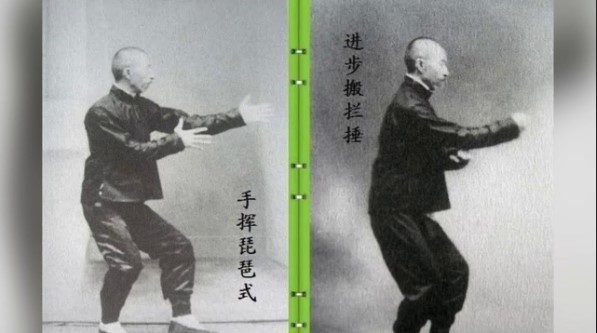
Master Sun Lutang
Sun Style was created by Master Sun Lutang (1861-1932) from Wanxian County in Hebei Province.He was a master of multiple internal Chinese Martial Arts styles and also learned the Wû style. He merge the Wû style with the Xingyi Quan's stepping methods and Bagua Zhang's waist method which created the Sun style.
Stances are upright and natural and foot work is nimble and agile. Movements are short and compact, and each hand technique is accompanied by a corresponding stepping action. Sun style is also characterized by its unique open-close hand movement. This movement helps to concentrate chi in the palms of the hands for delivery of short, deadly strikes.
Despite its martial roots the Sun style is a very gentle & soft style suitable for every age and any medical conditions.
Woo Style
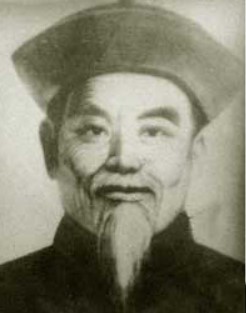
Master Wu Yuciang
Wu Yuxiang (Wu Yu-hsiang, 1812–1880) was the founder of Wu (Hao)-style t'ai chi ch'uan who was a senior student of Yang Luchan, the founder of Yang-style t'ai chi ch'uan. Wu developed his own style of t'ai chi and shared it with members of his family. The style is characterized by simplicity, clarity and compactness, with soft and slow movements. The movements are small, the hand never going farther than the foot, with an upright stance and strict footwork.